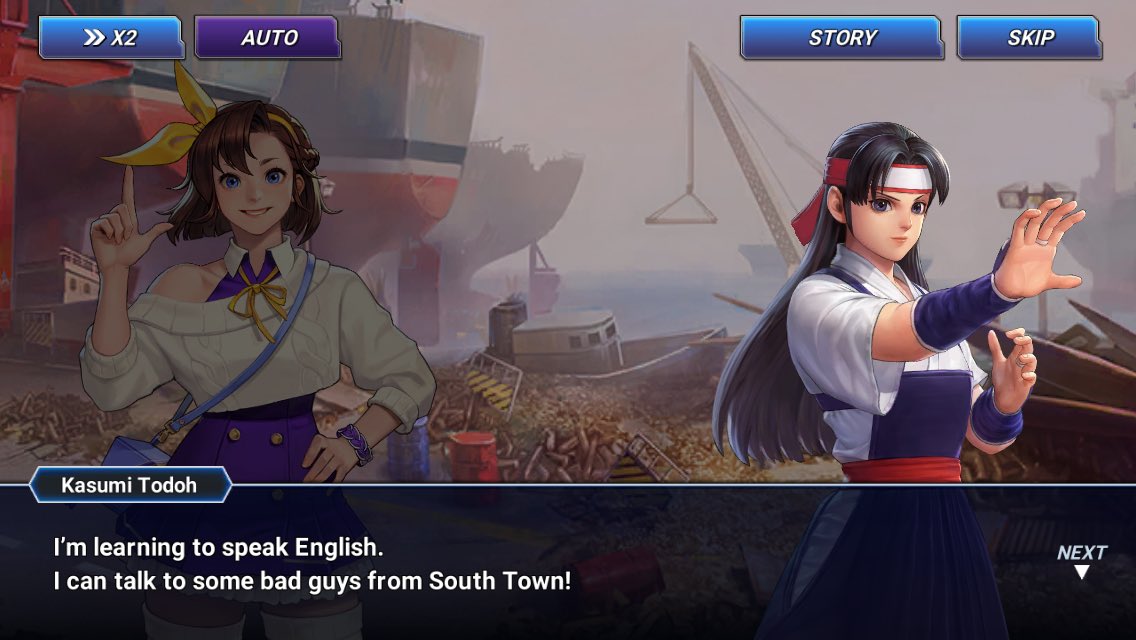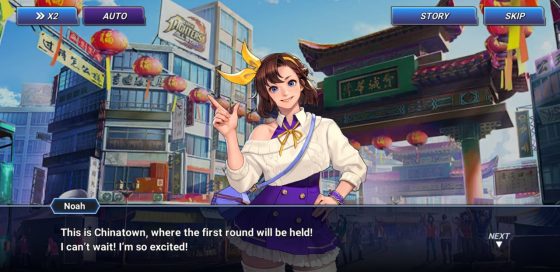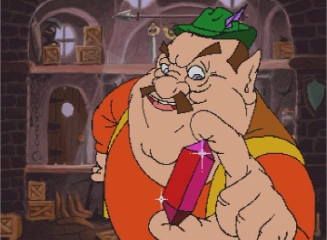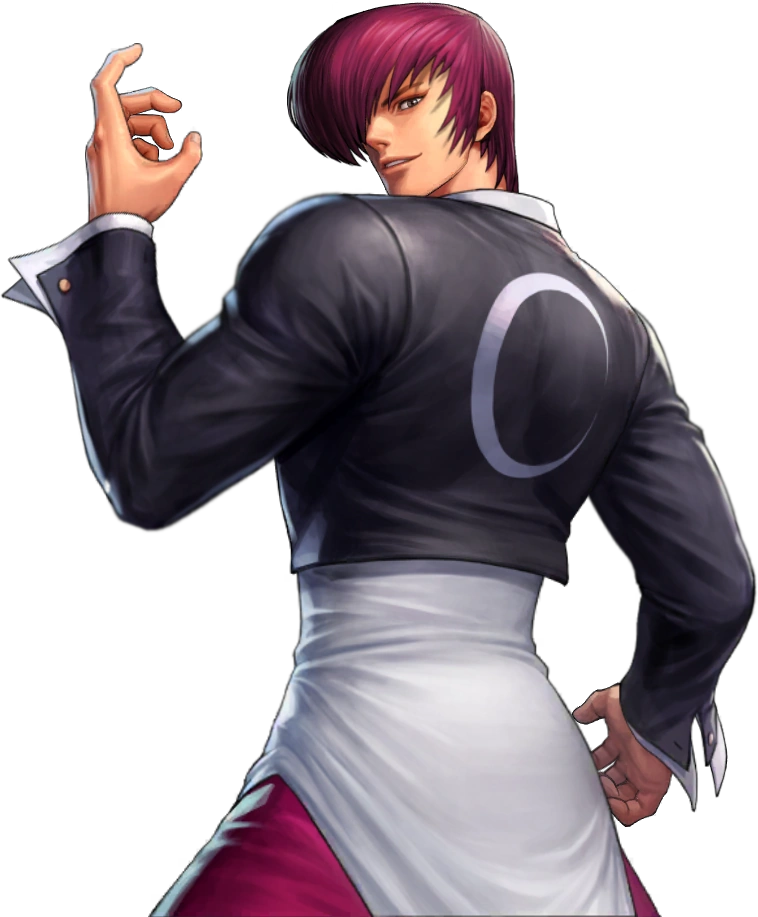KOF Allstar got all the hooks to catch my interest: it’s a
beat-em-up with collectible characters utilizing the KOF license developed by
the mobile company Netmarble. Obviously
I’m a huge KOF fan, I’ve enjoyed action mobile games with touch controls in the
past and I’ve read both good and bad things about Netmarble. The idea of a beat-em-up based on a fighting
game franchise where only two fighters are going at it at a time may seem like
an odd idea, but KOF has always had characters fighting gangs of enemies, it
was just rarely shown. I had some
careful optimism.
In preparation for the global version, I played the Japanese
version for a couple of weeks, both because I was excited to play and so that I
could write about any possible differences between the two. I couldn’t utilize every one of the game’s
features as my Japanese isn’t expert level, but from what I can tell the only
substantial difference is that the new content for the global version is coming
out much quicker because it has a year of updates from the Japanese version to
work with. Now that I’ve gotten to play
the global version, this review can be written proper.
The story presented recreates the first 5 mainline KOF games,
but with one major difference: the player.
You play as some kind of nondescript offscreen amnesiac who can somehow
change into KOF characters on the fly, something the game only barely mentions
as being surprising and gets next to no explanation. With your energetic tagalong companion Noah,
your character enters the KOF tournaments in hopes of getting the attention of
someone who knows him and finding more information on himself. After the main story mode the plot takes a
turn that leads into the extremely difficult “Epic Quest” story and there are
some side story events that come up for a limited time on top of that so
several hours of the game can be spent solely on the story mode.
The player seems to be based on the role of the team edit
from the games. When you don’t play with
an official team in the games, the characters in cutscenes not on your team speak
to what is presumably the player themselves, whom responds with generic
dialogue. This has been the case until
14, where no one gets any cutscene addressing them except for 4 teams
(presumably because they’d have to add a voice).
Much of the dialogue in the story is practically verbatim
from the games and it gets all the story bits down right. It’s clear that whoever wrote the story knows
KOF’s very thoroughly. The player and
Noah interact with the other fighters as they move through the tournament and
those opponents mention their reasons for entering. For many, once you beat them, Allstars plays
out what happens in their endings for that game too. They all act as they should and get their
turns in the spotlight, with some getting more than others as it does portray
KOF as an actual tournament where you don’t get to fight teams that lost their
matches. Since KOF 98 is the game with
no story and it’s the last one in the main story mode thus far, Allstar gets
creative and takes it off the rails a little and I’ll leave it at that.
As much as KOF Allstar’s story sticks to the source material,
there’s one factor that makes the overall plot anything but
straightforward: the tuners. Who the
tuners are and what they do is vague and needs to be pieced together by the
player, but the bottom line is that the player character is labeled by them as
a “bug.” Apparently the tuners are in
charge of maintaining the programming of either the actual KOF games or some
kind of allegory for them hinted at by certain lines of dialogue. For example, it’s mentioned at one point that
when the tournament is won the world is supposed to start over and also that
the Sacred Treasures ending in KOF 96 is a “secret ending.’
The player seems to be a major anomaly that essentially
makes the games go off the rails by causing the characters do different things
from what they’d normally do due to the player’s involvement. Since they aren’t allowed to interfere
directly, the tuners employ methods to slow the player down, which usually
means lots and lots and lots and lots of enemies to smack around.
The Tuners are a consistently interesting Matrix-like aspect
to the story. Their strategies translate
to zerg rushing more often than not, but their conversations on how to handle
the situation change as the story progresses and more of them get
involved. Their cryptic dialogue sheds
more light on exactly what is going on without giving too much away, but it’s
natural enough not to feel like it’s being intentionally cryptic, which is
partially thanks to a translation that’s passable enough to make it work, if
not good.
I feel the need to apologize to 428 for complaining about
typos. I had no idea how bad it could
get. I assume that because of the huge
amount of workload involved and the multiple languages on top of that the game
is riddled with missing or incorrect words.
I swear there’s a mistake in every five lines of dialogue. Luckily like 428 it’s never a disaster of a
translation job and the words that get flubbed are the unimportant pronouns and
predicates. It’s a pretty accurate translation
overall and reads like a native English speaker wrote them as opposed to a barely
edited Google Translate job. It’s leaps
and bounds better than the crap from the early games or Ignition Entertainment
and it’s kind of neat to see the old dialogue translated better even if that
means no more memes. I’ll give it that
much.
 |
| I'm not sure if that was awkwardly phrased because she's supposed to be talking in English for that line or not. |
My problem with the story is how it’s paced. Since this is a beat-em-up, almost the entire
story is spent fighting swarms of enemies, most of which are local gangs with
the pettiest reasons to fight you. Such
reasons include wanting to steal your invitation to enter KOF, making too much
noise, saying you’re the strongest person around and rabid Athena fans jealous
that she’s friends with you. It gets
ridiculous and the game knows it.
The story makes it clear that the reason you’re always being
attacked is because the tuners are coming up with whatever they can to stop you
and wear you down, but it still gets a bit tedious from a gameplay perspective
in long sessions and eventually the writers stop caring and throw enemies at
you for the hell of it. This story
needed about half the crowd fighting it has.
Once you’ve beaten your way through several stages of that you don’t
even fight the other teams in their entirety for the tournament. You only fight one member of the opposing
team to win, which changes depending on the difficulty level you’re on. Said fighter is also treated like little more
than a slightly tougher normal enemy even though the game has modes that play a
little bit more like traditional KOF.
The core gameplay is solid enough to carry the game though. KOF Allstar plays somewhat like a fusion of
KOF-i 2012 and a little iphone game called Combo Crew. You tap the screen to attack, swipe to dodge
roll, hold it down to guard and hold down and then slide for normal movement. Special moves are done by tapping their icons
and for super and ultra attacks, there’s a power meter to build up by doing
damage before you can use them. It’s
pretty standard stuff, but it works very well and there are three different
control styles to match a player’s preference as well as a “semi-auto” mode
that lets you play with one hand and choose when the AI uses its special
attacks as it fights with its basic attacks automatically.
Everything that makes a beat-em-up fun is present in KOF
Allstar. It’s responsive, every hit has that
needed punch to them, they got all the animations from the mainline games right
for each character and thanks to the inclusion of a striker system, tag-out
gameplay and easily cancelable moves, it’s possible to make some sick combos
and strategies. Since different attacks
have different ranges, windup and other such variables, there’s quick-thinking
involved to utilize what your character has versus what your enemies have, much
like the main games. It even avoids the
problem some beat-em-ups have with having to be perfectly aligned with your
target to damage. When you tap for your
basic attacks, the character automatically moves to the closest enemy they’re
facing. It’s more helpful than you’d
think.
Enemies come in a good variety, having different weapons,
attacks and animations with some genuinely good original designs that fit in
with the other SNK characters, even if they’re little more than meaningless
thugs. For some particularly
long-reaching attacks, the game telegraphs where they’ll hit with red areas on
the ground so it doesn’t feel like enemies get in cheap shots. It’s especially important for the some of the
more detailed bosses with screen-covering attacks.
That fun action gameplay is even more fun thanks to its
heavy layer of polish. The King of
Fighters Allstar looks and sounds great.
It almost doesn’t look like a mobile game. A lot of money and effort was put into this
game and it shows.
Characters do have flatter textures than the likes of KOF
14, but they animate well and don’t disappoint in any of the explosive moves
and multitude of onscreen enemies being tossed around by them. Outside of combat the menus and story
cutscenes are a bit basic-looking, but the moving character portraits are
beautifully made, even if they never emote, and there are occasionally
excellently made little animations in the story mode to accentuate specific
moments the talking portraits can’t do justice, like Rugal throwing his coat
off or Goenitz’s entrance.
The visuals seem to come with caveats though. Possibly due to how much it took to make just
one, backgrounds are limited. They look
nice and have a lot of visual detail, but the story re-uses many of them unless
they’re being used for a boss. I was
hoping each game would have its own set of stages based on the stages from each
game. There is some of that, like one
stage based on Britain
 |
| Allstar's artwork is worthy of the SNK brand. |
 |
| This is a place of evil. |
The music is similar to the graphics: great, but with some
caveats. As I expected, much of the
soundtrack is re-used from KOF 13, including the KOF 11 tracks that game used
for its B track, and I don’t think they’re used particularly effectively. If Netmarble can re-use one of those tracks,
they will, except it loops right before particularly standout parts so as not
to be distracting… Or interesting. The
worst of it is the basic boss theme, which is just the Ikari Warrior’s theme
from KOF 11 that loops the first few droning notes before the metal guitar solo
part it’s supposed to escalate to. It’s
used for every single non-major boss in the game and gets old fast.
The counterpoint to this problem is that KOF Allstar has
some really excellent original musical renditions of its own to go with that. The background music for stages before the
boss shows up is determined by the character you start with and when they can’t
use KOF 13’s music, they use their own, which sounds on par with SNK’s music. There’s a new rendition of the themes for the
New Faces team, Shingo, Kim’s KOF 96 team and even the American Sports team.
Final bosses all get their own new arrangements too, but my
favorite audio detail is that the menu music for story mode uses the character
select music from each game as a backbeat for a jamming remix. I would not be against a KOF Allstar
soundtrack release.
KOF Allstar is plenty competent as a beat-em-up, but what
will make or break the game for many players is the RPG elements. KOF Allstar isn’t exactly a pick-up-and-play
game because there are a great many variables to give players an advantage or
disadvantage in battle. It’s as much an
RPG as it is a beat-em-up and a free-to-play mobile game to boot. With that comes some grinding.
The premier grind is rubies.
Fighters? Cards? Extra smaller consumable items? It’s yours my friend, as long as you have
enough rubies.
Being a gacha game, you spend rubies you get from playing to
get fighters and cards at random. Most
characters have separate variants for the different games they’ve been in and
that can change their stats, rarity and what moves they have. Rarer fighters have better stats and a higher
starting maximum level. Some are
visually distinguished by their change in outfit (Athena, obviously), but for
the ones with a limited wardrobe Netmarble opted to use their alternate colors from
the games, meaning 96 Iori has purple hair, 98 Robert has a red jacket and 95
Goro has brown pants. That’s a nice
touch.
There are a series of different groupings you can use the
rubies on that give you the percentage chance of what you’ll get, but I don’t
think that was handled very well.
Instead of something like Yu-Gi-Oh booster packs, where every pack has
its own unique set of cards to go for, the groupings in KOF Allstar put only 1-3
unique fighters/cards with a large pool of regular fighters that are in every
pack, with the unique ones getting a higher chance of being obtained. Condensing everything into categories
would’ve made things much smoother and the way it’s done comes off as a
manipulative way to make players want to spend their real world money on their
ruby packs. I know that’s how
free-to-play games make their money a lot of the time, but it doesn’t seem
right to do that by inconveniencing players on the primary means of game
variety like this. At the very least
they should have the characters available to buy with real money. It’s not like fighting games aren’t doing
that already.
Rubies aren’t a complete slog to get if you’re patient. Allstar is generous with free stuff for
playing daily or completing objectives and that includes rubies every once in a
while. In fact, when you first start the
game you get a free ultra rare fighter of your choice and there have been the
“step-up” series of groupings, where after repeatedly spending half-off on
getting fighters, you get to choose from two ultra rare fighters/cards for your
third, full-price ruby purchase. That’s
how I got K’ and Maxima.
The problem is that there are a lot of limited time events
and chances are you’re only going to be able to get a complete 10-fighter
attempt once every few days, which again feels like it’s meant to manipulate
those who didn’t get what they want into buying rubies. There are also character variants you can
only get by playing events several times every day, which can be exhausting or
impossible if you start too late. It’s
best to go into the game ready to be content with what you have because there’s
no way in hell you’re going to catch-em-all.
If you just wanted to see what they looked like, the game
has a gallery mode that lets you view the special attacks and look at the
artwork and descriptions for all the fighters and equippable cards in the game,
even if you don’t have them. That’s
definitely worth doing with the cards because there’s a lot of fun call-backs
in those. In fact I’d recommend even
anyone not planning on playing to download the game just to have a look at its
gallery.
You’re going to be busy with whoever you get anyway because RPG
elements means a lot of time is spent suiting up. Every character starts with a max level
depending on their rarity, you level them up with experience-granting items,
increase their max level with a different category of items, spend items in a
grid to make them stronger after they’re leveled up, give them food items to
raise affinity and their stats, use a rock-paper-scissors color system for
extra damage, choose who’s leader on a team to use their special leader bonus, there
are three different card types to equip and there are three categories of
fighters that affect their stats. That’s
just the start.
Allstar does ease you into things by locking options until
you reach a certain rank, but once the meat of the game starts, some players
may find it hurts the pacing by making players lock down and start
micromanaging in a game franchise known for its super fast action, but players
of the first two Dissidia games should be right at home.
Grinding in KOF Allstar is done through challenges that
reward you with the items you need, be it for crafting or leveling up, but it
alleviates the tedium a bit with the “auto-battle” and skip tickets (called
auto-clear tickets in English even though it says “skip” right on its
picture). If you’re confident your team
is good enough, auto-battle lets the computer fight a specified number of times
for you while you leave the phone and go do something else. The AI for auto mode is competent enough,
simply dodge rolling when hit and attacking whatever is in front of them, so if
they’re able to tank through a level it can be a very efficient way to grind,
albeit no less time-consuming.
The skip tickets are made to be quick. As long as you’ve fulfilled all of a
challenge’s bonus requirements (like winning without losing a team member),
skip tickets automatically give you the rewards as though you cleared them.
Both these methods use up AP, a limited number of slowly
replenishing points meant to limit how many missions you can play at a certain
period of time, but I almost forgot it was there because AP can go above its maximum
and I almost always have an excessive stockpile of both it and the items that
recover it, making AP a complete non-issue.
I only ever ran out of AP after I used 24 skip tickets at once on a
difficulty level that required more AP than the others and occasionally after a
long series of auto-battles.
I think the AP meter may have been made to distract users from
the real limiter: gold. With a few very
specific exceptions you could count on one hand, every single thing you upgrade
in the game requires gold in addition to materials required. Using the materials is already a cost so gold
is a completely superfluous resource that only serves to waste the time of the
players with grinding that increases as upgrading characters get more expensive. If gold were taken out of the game, nothing would
be lost.
 |
| I am willing to lose the crazy gold farming stage. |
There’s no shortage of things to do in KOF Allstar
regardless of what level characters are, so if one part of the game is getting
frustrating, there are other things to spend time on. The story is already a big part of the
package, but there are also online competitive features, a wide variety of
regular and weekly challenges and a time attack mode that lets you use a
rotating selection of max level fighters to compete for the fastest time
through a gauntlet. Time attack mode is
a great way to see what other characters you may not have can do. Everything coupled with the character
management and strategic aspect that ensures I never run out of things to do.
The limiting free-to-play aspects of its design hold it
back, but the King of Fighters Allstar still wins me over with fun action gameplay,
some convenient features, a solid story and presentation, a strong attention to
detail fans can enjoy and a huge selection of things to do with its different
game modes and ever-changing events. I’ve
already sunk dozens of hours into it and I have no intention of stopping. I give The King of Fighters Allstar a 7.5 out
of 10.





Great explanation
ReplyDelete